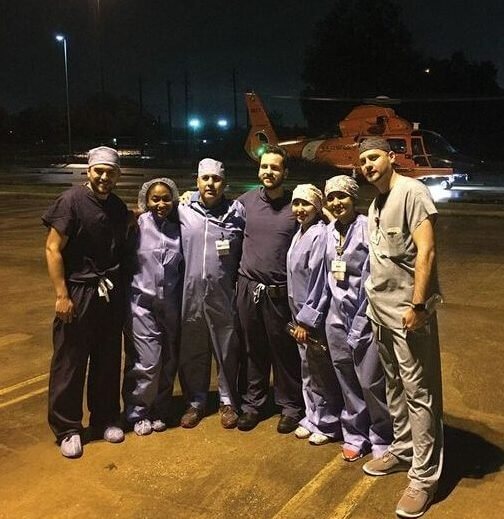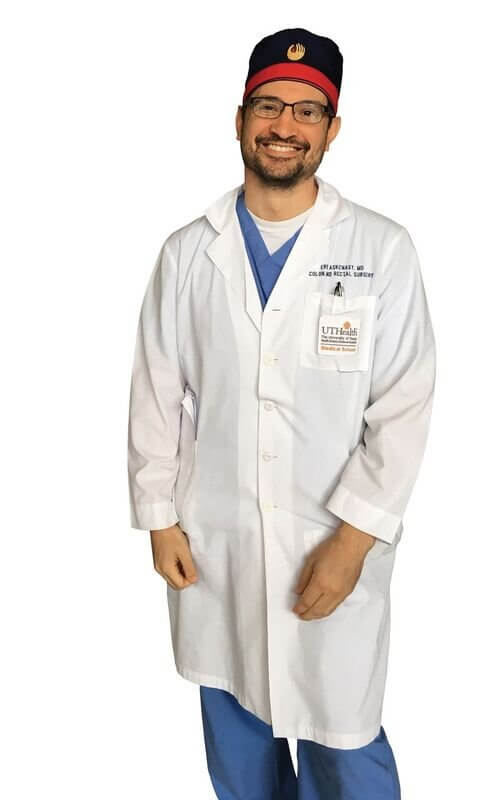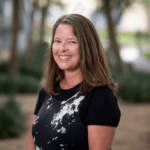The Craniotomy Crew

Heading into work at Lyndon B. Johnson Hospital on Friday, Aug. 25, Erik Askenasy knew he wouldn’t be leaving anytime soon.
“I packed a duffel bag,” said Askenasy, 37, a general and colorectal surgeon who spent five days riding out Tropical Storm Harvey at the northeast Houston hospital.
During that time, LBJ became an island. Surrounded by five feet of water, it also succumbed to the same punishing winds that the rest of the area endured.
And smack in the middle of the epic storm, a worst-case scenario unfolded. Askenasy and other members of the ride-out team—staffers assigned to ride out the storm at work—were called on to perform a surgery that the hospital is not set up to do, that Askenasy and the operating room team were not prepared to do, and for which there were no designated tools or instruments.
A craniotomy—brain surgery.

Erik Askenasy, M.D.
LBJ is a Level III trauma center, which provides comprehensive medical and surgical services with the exception of neurosurgical care.
In other words, they don’t do brain surgery.
………………..
Around 8 p.m., a middle-aged man arrived at the hospital on the back of a dump truck with a large bump protruding from his head.
“The story that we had received from his family was that a son or grandson had gone missing in the middle of the flood and he went out on an ATV to go look for him,” said Merry Philip, administrative director of nursing at LBJ’s emergency center. “During the time he was out, he hit something and got a head injury. As soon as he got here, we started doing our scans and we found out he had a subdural hematoma.”
Time to activate the trauma team. Askenasy, a trained trauma surgeon, examined the patient’s scans.
“I saw he had a significant bleed in his brain, as well as a large bleed between his brain and his skull,” said Askenasy, a UTHealth assistant professor. “Normally, we’d send this guy to Ben Taub Hospital or Memorial Hermann, both Level I trauma centers. But no one could get in by ground or air.”
The hospital was eerily quiet at this point. Although the storm raged outside, the flood of people who were hurt or displaced had not yet begun to arrive.
As Askenasy hurried to talk to the patient, he had a sneaking feeling he might need to operate to relieve the pressure building inside the man’s head. He started to play out the scenario in his mind.
“I run in and talk to the dude,” Askenasy recalled. “I can tell he’s altered. He’s confused, searching for words. He’s not there.”
Askenasy called Tien Ko, M.D., chief of surgery and chief of staff at the hospital, and said: “I don’t see how we’ll be able to get this man to Hermann.” Ko, in turn, communicated with Alan Vierling, executive vice president and administrator of LBJ Hospital, who was on site, and got him up to speed on the situation.
Meanwhile, hospital staff did what they always do in cases like this: hustled to find a way to get the patient to a Level I trauma center.
“We called CMOC [Catastrophic Medical Operation Center] and said we have a patient who is critically ill; we need to get him out,” Philip said.
At the same time, Askenasy went upstairs to the operating room and spoke to the nurses. “We may have to do a craniotomy,” he told them. “I need to find some instruments.’”
“Dr. Askenasy explained step by step what he was going to do and that really helped,” said Alberto Cortez, an OR nurse clinician and the charge nurse.
“He was really calm, too,” said Ashley Acosta, an OR nurse clinician. “He made us feel really comfortable, because we had never done this. We all talked about what we needed and kind of ran around to get supplies. We asked Dr. Askenasy what tools we should use, and the anesthesia faculty gave me a number to a neurology nurse at Memorial Hermann to ask about what we needed. Most of the stuff we didn’t have because we don’t do neuro, so we kind of just had to improvise.”
Cortez found drill bits used by ear, nose and throat surgeons that would work to bore burr holes into the patient’s skull. The team also got their hands on a Gigli saw—a flexible wire saw used to cut bones—that would allow Askenasy to perform the surgery he had planned: Imagine a game of connect-the-dots, except the dots are burr holes and instead of drawing a line between them, a surgeon cuts the bone between them. Once that’s done, a piece of the skull can be removed.
“The bone pops off and you’re staring at the brain,” Askenasy said.
…………….
A busy general and colorectal surgeon, Askenasy spends three days a week at UTHealth and two at LBJ. He operates on Mondays at LBJ, and on Fridays he typically sees patients in clinic.
Twelve years ago, though, he began his medical career in neurosurgery.
“I was at Baylor for two years in the neurosurgical program and then I decided I enjoyed general surgery because there was more opportunity to do mission work,” Askenasy said. During those two years at Baylor College of Medicine, however, he did have some surgical responsibilities.
“As a resident, I was assisting and taking part in surgeries,” Askenasy said, “but I had an attending with me in the room. I was never unsupervised.”
He had been present for craniotomies, but he had never been the person in charge. And the last time he’d been involved in any type of neurosurgery was a decade ago.
……………..
Askenasy and the OR team waited to hear if they were headed to surgery or if there was any way to transport the patient. Essentially, hospital personnel were planning for two potential situations at once, waiting for definitive word on which way it would go.
Askenasy called a friend who’s a neurosurgeon and told him the scenario. His friend said, “You go, buddy. You’ve got to do it.”
He also went back downstairs and deliberated again with Vierling and the attending physician, Stephen Hecht, M.D. They wanted to make sure they could give the patient the best possible care under next-to-impossible circumstances.
“After an hour, we finally got the last call from CMOC, who said the Coast Guard cannot fly in these wind conditions, that it would be dangerous to land,” Philip said. “CMOC did say they could get a helicopter in the following morning. We said, okay. Next? What do we do now?”
By this point, the patient was in decline. He had grown nauseous and had started throwing up, signs of a neurological deficit.
It was time to talk to the patient’s family, most of whom were assembled in the hospital. Askenasy, who is Colombian, communicated with the Hispanic-American family in Spanish.
He told them in straightforward terms what they were facing. Under ideal circumstances, he explained, the patient would be transferred to a facility equipped for neurosurgery. Since that was impossible, they were left with two choices: wait and hope for transport, or proceed with surgery to remove the blood clots and relieve the pressure in the patient’s brain.
“I’m a very direct person,” Askenasy said. “Families deserve honesty. I told them I am not a neurosurgeon and that apart from very extreme circumstances, I would never consider doing this surgery.”
The patient’s family responded: “Are you good?” Askenasy chuckled at the memory.
He reiterated to the family: “I think I can do this, but I am not a neurosurgeon.”
The family asked: “Can you give us some time?”
Askenasy gave them 10 minutes, then returned. The family told him to go ahead with the surgery, that they believed this was the right decision.
The OR team prepped and intubated the patient, shaving and sterilizing the area of his head that was protruding, which took close to 30 minutes.
Then, Askenasy prayed.
“I’m a person of faith,” he said. “In a situation like this, I pray. Absolutely I pray. God give me wisdom, understanding, peace and clarity of mind to help this gentleman. And it wasn’t just me. It was everybody—this was a total team effort.”
………………..
The surgery began around midnight and lasted close to two hours.
Throughout the drilling, Askenasy had to be very careful not to disrupt the brain. Ordinarily, instruments for this type of procedure include a drill that stops automatically when it bores through the bone. The drill Askenasy was using had no such feature, so he had to proceed slowly, stopping to make sure he wasn’t going too far. After drilling the four burr holes and sawing lines between them, Askenasy had some trouble wedging an instrument under the scalp to pop out the mass of bone. He called his neurosurgeon buddy who recommended that he make the burr holes larger. That worked.
“We were able to remove part of the skull and visualize the clots on the brain,” Askenasy said. “We were able to remove the clot that was compressing his brain as well as the one in one of the lobes. We closed his scalp and placed the bone flap we removed in his abdominal tissue—that goes with him and doesn’t get lost in a freezer somewhere.”
Members of the OR team said one of the clots was huge—the size of a fist.
…………………
Elsewhere, another piece of the drama was unfolding.
Midway through the surgery, the Coast Guard called LBJ Hospital to say they could collect the patient within the next few hours. Vierling ran upstairs and asked the OR team if the patient would be stable enough to transfer. The team said yes.
Then, hospital staff had to find a place for the helicopter to land. Ordinarily, Memorial Hermann Life Flight and other choppers land in front of the hospital, but that was impossible because the area was underwater.
“We had a couple of our guys that are military who went out and found an area in the physician parking lot where the helicopter could land,” Philip said. “There were three cars parked there, though, and no one knew who they belonged to. We took pictures of the license plates and asked the Houston Police Department to help us find who owned these cars and where they worked in the facility. Ultimately, they were all able to move their cars.”
Once the surgery was complete, the patient was taken to ICU. Askenasy showed the post-op team how to take care of him, then went back to the call room, turned on his PlayStation 4, and reflected on what had just happened.
“Without Dr. Askenasy, we don’t know what we would have done,” Philip said. “There’s no other general surgeon who would have been able to do what he did. Without the surgery, if the patient had not died he would have been brain damaged, absolutely.”
And the child that the patient had gone out to rescue in the first place? He was found, safe, and was waiting anxiously with the rest of the family at LBJ to learn the fate of his loved one.
Nearly two hours after the surgery, an LBJ staffer went out in the rain with a basic flashlight to help guide the Coast Guard to the improvised landing area in the physician parking lot. Within a matter of minutes, the chopper lifted off with the patient on board, bound for Memorial Hermann Hospital.
Today, the patient is doing well.
“My understanding is that he’s fine,” Askenasy said. “He woke up, asked to go home and was discharged within a few days.”
………………..
One week after the surprise craniotomy, Askenasy took the entire OR team out to eat at Pappasitos.
A week after that he headed out to Guatemala for mission work with a group called Faith in Practice. “We will typically perform 80 to 100 surgeries the week we are there,” he said.
Mission work helps Askenasy think on his feet, a quality that came in handy during the craniotomy.
“In the field, you have to think outside the box,” he said. “We have so many luxuries in the U.S., but you can provide well for patients with much less.”
Askenasy also believes that no one’s life experiences are accidental.
“I did two extra years of medical training because of my time in neurosurgery,” he said. “Sometimes you don’t get to see the reason you’ve gone through what you’ve gone through. But I did.”

